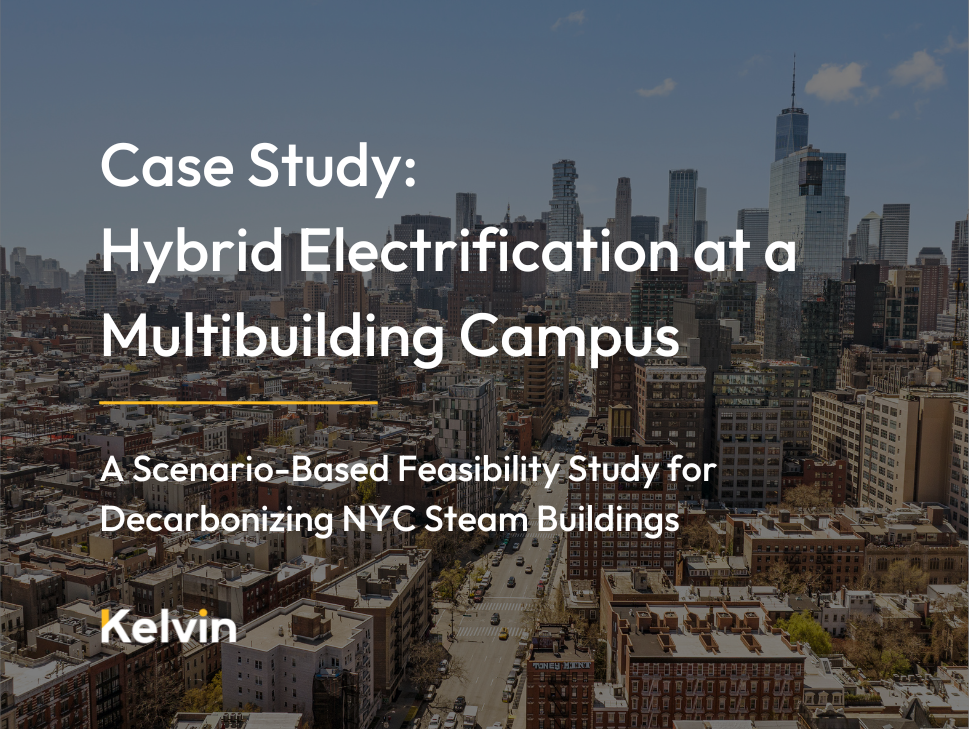
A Scenario-Based Feasibility Study for Decarbonizing NYC Steam Buildings
Introduction:
Kelvin worked with a real estate partner, and Inglese Architecture & Engineering under NYSERDA’s Empire Building Challenge (EBC) to conduct a detailed modeling study on decarbonization options for a seven-building, rent-regulated multifamily complex in New York City. The EBC program enables building owners and technical teams to evaluate practical decarbonization scenarios with the intent of informing replicable strategies across New York State’s multifamily building stock.
This case study outlines the modeling effort conducted for the campus, focused on assessing hybrid and full electrification options and their cost, emissions, and regulatory implications. The work is intended as a technical and policy-facing reference for owners, engineers, and agencies seeking effective strategies to decarbonize steam-heated buildings without compromising long-term financial viability.
| Project Objectives | Project Context |
|
|
Scenarios Modeled
Five modeled scenarios reflect a range of technology and control configurations. These were evaluated across energy use, capital and operating costs, and regulatory outcomes:
- Base Case: Existing gas-fired steam and DHW systems with no changes
- Simple Hybrid: Adds heat pumps in apartments for cooling and partial heating; gas remains primary heating source on cold days; no centralized controls or storage
- Smart Hybrid: Same as above, but with centralized controls and distributed storage to enable load management and potential participation in demand response
- Simple Full Electrification: Fully replaces steam and DHW with electric heat pumps, no controls, no storage
- Smart Full Electrification: Full electrification with added storage and integrated controls for load shaping and demand management
Key Findings
- Electrification without controls increases OPEX:
Modeling shows that full electrification with smart controls achieves the greatest reduction in site energy use intensity (EUI), cutting usage by approximately 52 percent. However, this comes at more than double the capital cost and with higher annual operating expenses compared to the hybrid alternative. Smart Hybrid delivers a 44 percent EUI reduction, with lower implementation and operational costs, making it a more viable near-term strategy under current tariff and policy conditions.
- Storage and control make electrification viable:
Scenarios with centralized control and distributed storage allowed the building to participate in future demand response and time-of-use programs. These systems helped smooth peak loads and recover revenue, making the economics of electrification more favorable.
- Load data is critical for system sizing:
The roadmap includes recommendations to install flow meters and temperature sensors to collect empirical data on DHW and heating demand before large capital deployment. Avoiding over-sizing is key to controlling upfront cost and maximizing system efficiency. - Phased implementation enables scale:
The roadmap proposes first implementing the smart hybrid configuration in one building. This allows for evaluation of performance, resolution of local grid constraints, and planning for site-wide deployment as infrastructure permits.
Modeled Energy and Cost Impact (per building)
|
Metric |
Baseline (2024) |
Smart Hybrid |
Smart Full Electric |
|
Site EUI (kBTU/SF/year) |
101.7 |
57.0 |
48.5 |
|
Fossil Fuel Use (Therms) |
144,109 |
64,929 |
8,358 |
|
Electricity Use (kWh) |
1.3M |
2.01M |
2.36M |
|
Net Capex Cost (per dwelling unit) |
— |
$15,108 |
$31,927 |
|
Annual Opex Increase (per dwelling unit) |
— |
$2,936 |
$3,477 |
Note: All values are based on modeled performance. No measures have been implemented to date.
Lessons Learned
- Electrification must be contextual: Strategy must account for tariff structures, building loads, and infrastructure readiness. One-size-fits-all approaches can increase operating costs and regulatory risk.
- Controls and storage are non-negotiable: Without them, electric systems can become cost sinks. With them, buildings can shift load, participate in grid programs, and mitigate cost volatility.
- Long-term value is driven by operating cost: Capital incentives are important, but electricity escalation, inefficient sizing, or unmanaged peak loads can quickly erode financial viability.
- Data beats assumptions: Empirical measurement of hot water and space heating demand allows for right-sizing systems. Without it, system design is likely to overspend or underperform.
- Policy and utility alignment is required: Electrification at scale will require dynamic electricity tariffs, heating-season demand response, and coordinated utility infrastructure upgrades.
- Start small, validate, then scale: Sequencing is critical. Electrifying one building first allows time to assess performance, mitigate risk, and align with utility timelines.
Replication Potential
The modeled roadmap is applicable to all seven buildings in the campus and may be relevant to thousands of similar master-metered, steam-heated buildings across New York City.
Methodology
This analysis was developed using standard engineering practices and real building data, with an emphasis on creating a replicable framework that can be applied to other multifamily properties.
Baseline Analysis
We began with a 36-month utility bill review, normalized for weather, to determine average energy use by end use: space heating, domestic hot water (DHW), cooling, lighting, and plug loads.
Existing Conditions and Load Calculations
Site visits, mechanical drawings, and maintenance records were used to evaluate existing equipment performance and remaining useful life. We also completed heating and cooling load calculations for each unit type to determine whether systems were appropriately sized.
Scenario Modeling
All decarbonization options were modeled using Excel spreadsheets that enabled scenario-based comparisons of different system configurations by incorporating:
- Equipment performance metrics (e.g. COPs, seasonal adjustments)
- Projected utility rates and escalation
- Maintenance and operating costs
- Incentive programs and tax credits
Local Law 97 compliance thresholds and penalty projections
Each system change was modeled with time-based phasing and operational assumptions to reflect realistic implementation schedules and grid limitations.

